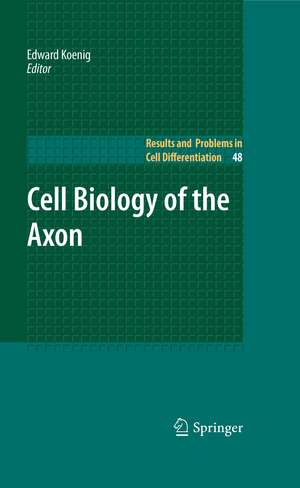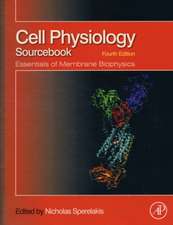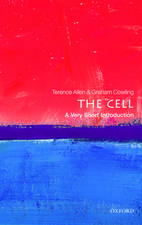Cell Biology of the Axon: Results and Problems in Cell Differentiation, cartea 48
Editat de Edward Koenigen Limba Engleză Paperback – 14 mar 2012
Five basic areas (I to V) germane to axonal biology are highlighted, beginning with (I) signaling interactions mediating myelination, and differentiation of axonal membrane domains; (IIa) issues surrounding organization and transport dynamics of neurofilaments in axons, (IIb) mechanisms regulating microtubule organization and dynamics, misregulation of which causes axonal degeneration, and (IIc) the roles actin binding proteins play in regulating organization and functions of the actin filament system in mature and growing axons; (IIIa) myosin motor proteins and cargoes intrinsic to the axon compartment, (IIIb) mitochondrial transport motors, and imperatives governing transport dynamics and directional delivery, (IIIc) mechanisms mediating retrograde signaling associated with NGF’s role in trophic-dependent neuronal survival, and (IIId) potential for impaired subcellular targeting of a -synuclein as a mechanism for accumulation of Lewy body inclusions in synucleinopathies; (IVa) occurrence and organization of discrete ribosome-containing domains in axons, (IVb) endogenous mRNAs, classes of proteins translated locally, and RNP trafficking in axons, (IVc) importance of locally synthesized nuclear encoded mitochondrial proteins for maintenance, function and survival of axons, (IVd) occurrence of RNA trafficking from glial cells to axons, and significance glial RNA transcripts may play in expression in axons and axon terminals, (IVe) RNA trafficking and localization of RNA transcripts in axonal growth cones, and signaling pathways that modulate local protein synthesis for directionalelongation, and (IVf) genetic and molecular defects underlying spinal muscular atrophy, and roles that SMN gene product plays as a molecular chaperone in mRNA transport and translation; (Va) injury-induced local synthesis of a protein forming a retrograde signaling complex in axons to stimulate regeneration, and (Vb) endogenous and exogenous factors that condition axonal regenerative capacity in PNS and CNS, including injury-induced activation of specific genes governing regeneration.
Emergent complexities revealed in this volume compel a major revision in the traditional conceptual model of the axon’s intrinsic makeup and capacities.
| Toate formatele și edițiile | Preț | Express |
|---|---|---|
| Paperback (1) | 1220.57 lei 6-8 săpt. | |
| Springer Berlin, Heidelberg – 14 mar 2012 | 1220.57 lei 6-8 săpt. | |
| Hardback (1) | 1226.73 lei 6-8 săpt. | |
| Springer Berlin, Heidelberg – 11 sep 2009 | 1226.73 lei 6-8 săpt. |
Din seria Results and Problems in Cell Differentiation
- 18%
 Preț: 1391.73 lei
Preț: 1391.73 lei - 15%
 Preț: 597.16 lei
Preț: 597.16 lei -
 Preț: 387.96 lei
Preț: 387.96 lei - 5%
 Preț: 373.33 lei
Preț: 373.33 lei -
 Preț: 382.18 lei
Preț: 382.18 lei -
 Preț: 385.08 lei
Preț: 385.08 lei - 15%
 Preț: 644.82 lei
Preț: 644.82 lei - 15%
 Preț: 634.00 lei
Preț: 634.00 lei -
 Preț: 387.20 lei
Preț: 387.20 lei -
 Preț: 387.75 lei
Preț: 387.75 lei - 15%
 Preț: 643.34 lei
Preț: 643.34 lei -
 Preț: 382.18 lei
Preț: 382.18 lei -
 Preț: 394.71 lei
Preț: 394.71 lei -
 Preț: 390.08 lei
Preț: 390.08 lei -
 Preț: 381.43 lei
Preț: 381.43 lei -
 Preț: 385.47 lei
Preț: 385.47 lei -
 Preț: 385.47 lei
Preț: 385.47 lei -
 Preț: 391.22 lei
Preț: 391.22 lei - 18%
 Preț: 1227.04 lei
Preț: 1227.04 lei - 20%
 Preț: 561.68 lei
Preț: 561.68 lei - 5%
 Preț: 1418.27 lei
Preț: 1418.27 lei -
 Preț: 386.00 lei
Preț: 386.00 lei -
 Preț: 377.95 lei
Preț: 377.95 lei -
 Preț: 391.61 lei
Preț: 391.61 lei -
 Preț: 388.52 lei
Preț: 388.52 lei - 18%
 Preț: 1380.63 lei
Preț: 1380.63 lei - 15%
 Preț: 639.25 lei
Preț: 639.25 lei - 18%
 Preț: 1220.12 lei
Preț: 1220.12 lei - 15%
 Preț: 642.51 lei
Preț: 642.51 lei - 15%
 Preț: 640.37 lei
Preț: 640.37 lei - 18%
 Preț: 1222.49 lei
Preț: 1222.49 lei - 18%
 Preț: 946.41 lei
Preț: 946.41 lei -
 Preț: 387.38 lei
Preț: 387.38 lei - 18%
 Preț: 1228.47 lei
Preț: 1228.47 lei - 15%
 Preț: 642.51 lei
Preț: 642.51 lei - 18%
 Preț: 1663.00 lei
Preț: 1663.00 lei - 18%
 Preț: 1225.62 lei
Preț: 1225.62 lei
Preț: 1220.57 lei
Preț vechi: 1488.50 lei
-18% Nou
Puncte Express: 1831
Preț estimativ în valută:
233.56€ • 249.75$ • 194.73£
233.56€ • 249.75$ • 194.73£
Carte tipărită la comandă
Livrare economică 17 aprilie-01 mai
Preluare comenzi: 021 569.72.76
Specificații
ISBN-13: 9783642260308
ISBN-10: 3642260306
Pagini: 376
Ilustrații: XVI, 360 p. 50 illus., 22 illus. in color.
Dimensiuni: 155 x 235 x 20 mm
Greutate: 0.53 kg
Ediția:2009
Editura: Springer Berlin, Heidelberg
Colecția Springer
Seria Results and Problems in Cell Differentiation
Locul publicării:Berlin, Heidelberg, Germany
ISBN-10: 3642260306
Pagini: 376
Ilustrații: XVI, 360 p. 50 illus., 22 illus. in color.
Dimensiuni: 155 x 235 x 20 mm
Greutate: 0.53 kg
Ediția:2009
Editura: Springer Berlin, Heidelberg
Colecția Springer
Seria Results and Problems in Cell Differentiation
Locul publicării:Berlin, Heidelberg, Germany
Public țintă
ResearchCuprins
Axonal Protein Synthesis and the Regulation of Local Mitochondrial Function.- Critical Roles for Microtubules in Axonal Development and Disease.- Myelination and Regional Domain Differentiation of the Axon.- Spinal Muscular Atrophy and a Model for Survival of Motor Neuron Protein Function in Axonal Ribonucleoprotein Complexes.- Local Translation and mRNA Trafficking in Axon Pathfinding.- NGF Uptake and Retrograde Signaling Mechanisms in Sympathetic Neurons in Compartmented Cultures.- Organizational Dynamics, Functions, and Pathobiological Dysfunctions of Neurofilaments.- Protein Synthesis in Nerve Terminals and the Glia–Neuron Unit.- Myosin Motor Proteins in the Cell Biology of Axons and Other Neuronal Compartments.- Retrograde Injury Signaling in Lesioned Axons.- Actin in Axons: Stable Scaffolds and Dynamic Filaments.- Regulation of mRNA Transport and Translation in Axons.- Axon Regeneration in the Peripheral and Central Nervous Systems.- Mitochondrial Transport Dynamics in Axons and Dendrites.- The Paradoxical Cell Biology of ?-Synucle.- Organized Ribosome-Containing Structural Domains in Axons.
Textul de pe ultima copertă
Recent years have witnessed striking advances in research on axons at a cellular level that substantially impact our current understanding of axonal biology. Newer findings and their ramifications are critically reviewed in the 16 chapters of this volume by authors highly qualified by virtue of their scientific contributions to research areas they know and write about.
Five basic areas (I to V) germane to axonal biology are highlighted, beginning with (I) signaling interactions mediating myelination, and differentiation of axonal membrane domains; (IIa) issues surrounding organization and transport dynamics of neurofilaments in axons, (IIb) mechanisms regulating microtubule organization and dynamics, misregulation of which causes axonal degeneration, and (IIc) the roles actin binding proteins play in regulating organization and functions of the actin filament system in mature and growing axons; (IIIa) myosin motor proteins and cargoes intrinsic to the axon compartment, (IIIb) mitochondrial transport motors, and imperatives governing transport dynamics and directional delivery, (IIIc) mechanisms mediating retrograde signaling associated with NGF’s role in trophic-dependent neuronal survival, and (IIId) potential for impaired subcellular targeting of a -synuclein as a mechanism for accumulation of Lewy body inclusions in synucleinopathies; (IVa) occurrence and organization of discrete ribosome-containing domains in axons, (IVb) endogenous mRNAs, classes of proteins translated locally, and RNP trafficking in axons, (IVc) importance of locally synthesized nuclear encoded mitochondrial proteins for maintenance, function and survival of axons, (IVd) occurrence of RNA trafficking from glial cells to axons, and significance glial RNA transcripts may play in expression in axons and axon terminals, (IVe) RNA trafficking and localization of RNA transcripts in axonal growth cones, and signaling pathways that modulate local protein synthesis for directionalelongation, and (IVf) genetic and molecular defects underlying spinal muscular atrophy, and roles that SMN gene product plays as a molecular chaperone in mRNA transport and translation; (Va) injury-induced local synthesis of a protein forming a retrograde signaling complex in axons to stimulate regeneration, and (Vb) endogenous and exogenous factors that condition axonal regenerative capacity in PNS and CNS, including injury-induced activation of specific genes governing regeneration.
Emergent complexities revealed in this volume compel a major revision in the traditional conceptual model of the axon’s intrinsic makeup and capacities.
Five basic areas (I to V) germane to axonal biology are highlighted, beginning with (I) signaling interactions mediating myelination, and differentiation of axonal membrane domains; (IIa) issues surrounding organization and transport dynamics of neurofilaments in axons, (IIb) mechanisms regulating microtubule organization and dynamics, misregulation of which causes axonal degeneration, and (IIc) the roles actin binding proteins play in regulating organization and functions of the actin filament system in mature and growing axons; (IIIa) myosin motor proteins and cargoes intrinsic to the axon compartment, (IIIb) mitochondrial transport motors, and imperatives governing transport dynamics and directional delivery, (IIIc) mechanisms mediating retrograde signaling associated with NGF’s role in trophic-dependent neuronal survival, and (IIId) potential for impaired subcellular targeting of a -synuclein as a mechanism for accumulation of Lewy body inclusions in synucleinopathies; (IVa) occurrence and organization of discrete ribosome-containing domains in axons, (IVb) endogenous mRNAs, classes of proteins translated locally, and RNP trafficking in axons, (IVc) importance of locally synthesized nuclear encoded mitochondrial proteins for maintenance, function and survival of axons, (IVd) occurrence of RNA trafficking from glial cells to axons, and significance glial RNA transcripts may play in expression in axons and axon terminals, (IVe) RNA trafficking and localization of RNA transcripts in axonal growth cones, and signaling pathways that modulate local protein synthesis for directionalelongation, and (IVf) genetic and molecular defects underlying spinal muscular atrophy, and roles that SMN gene product plays as a molecular chaperone in mRNA transport and translation; (Va) injury-induced local synthesis of a protein forming a retrograde signaling complex in axons to stimulate regeneration, and (Vb) endogenous and exogenous factors that condition axonal regenerative capacity in PNS and CNS, including injury-induced activation of specific genes governing regeneration.
Emergent complexities revealed in this volume compel a major revision in the traditional conceptual model of the axon’s intrinsic makeup and capacities.
Caracteristici
First complete overview on axonal biology Includes the latest advances in axonal biology Written by leading scientist of the field Includes supplementary material: sn.pub/extras








